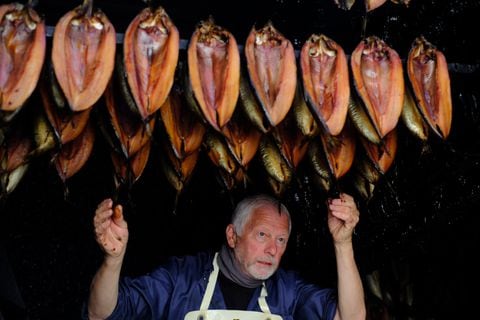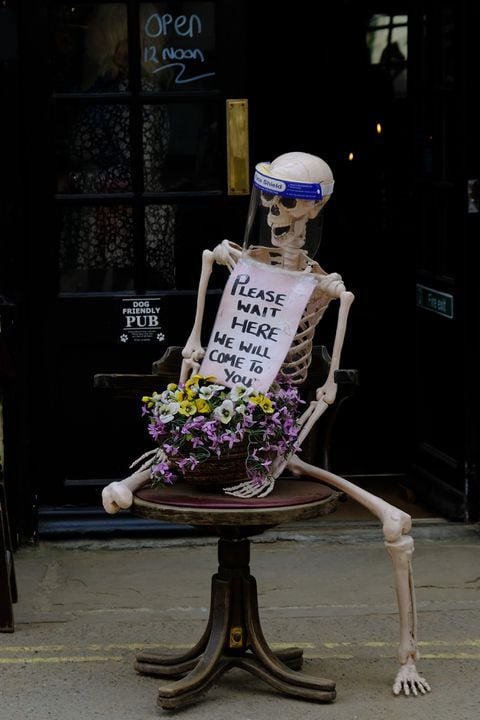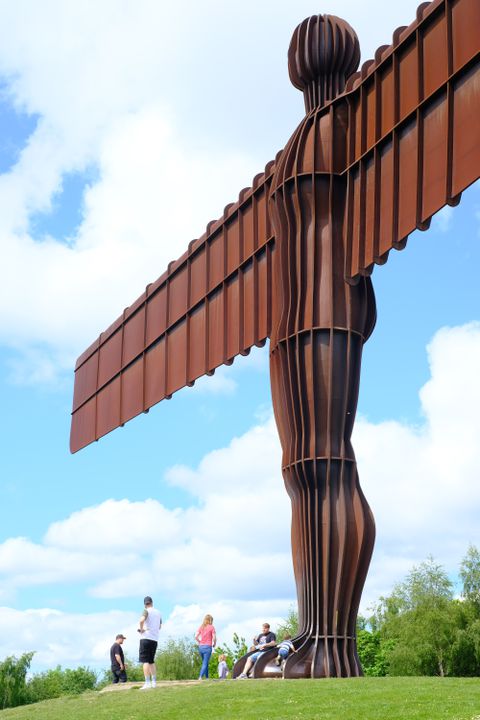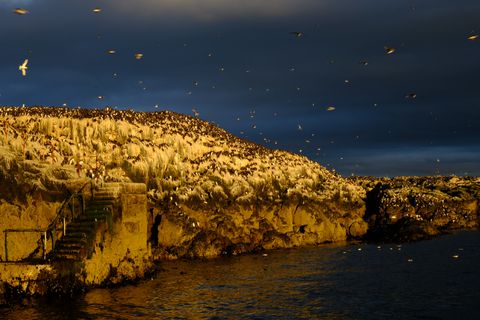Britain, nationalism and the complicated joy of vacationing in your own country
In the 1860s, a consortium of businessmen commissioned a hotel for the flourishing spa town of Scarborough, on the North Yorkshire coast. It was built above St. Nicholas Cliff and laid out in a gargantuan V, in honor of Queen Victoria. Six million bricks were used in its construction; four domed towers completed the imposing profile. When the Grand opened its doors, in 1867, a hydraulic ascending room — an early elevator — ferried well-heeled guests to the upper floors.
It was “a princely undertaking,” wrote a journalist at the Leeds Intelligencer, with customary Victorian floridity. For a time it was the largest hotel in Europe, a triumphal monument to a town on the make.
One and a half centuries later, I stood in a three-hour queue to check in to its modern incarnation, slowly losing the will to live.
From the Tripadvisor reviews, I should have known. “Hotel from hell,” read one. “Avoid Avoid Avoid!” warned another. Today, the Grand Scarborough is a gaudy shadow of its founders’ blueprint, its foyer festooned in pleather furnishings and garish carpet. Behind the reception desk, two harried men juggled room keys and sheaves of paper. Everyone in the queue was coping with the tedium Britishly by getting drunk. A woman pushed a small case of Budweiser in a stroller.
I sighed. This was pretty much what I’d expected.
In 2003, a curious little book appeared by the cash registers of London’s bookshops. I never bought “Crap Towns,” but I thumbed through it occasionally when waiting in line, and I found a condescending amusement in the premise, which was summarized in the opening line: “Britain is crap.”
At one level it was harmless stuff, channeling a national talent for self-deprecation that still finds expression in Twitter accounts like @NoContextBrits, a mordant celebration of British mediocrity. But it was also of its moment. Though the book was careful to select towns from all parts of the country, most of its scorn landed on England, and the principal allegation was clear: The English provinces in the new millennium were risible and reactionary, stagnant backwaters in a country past its prime.
For a young person, born and raised in London and keen to experience the world, this was obvious and unarguable. At the time, I wanted nothing more than to travel overseas, at least partly because I deplored the gray familiarity of the country I called home.
But I have wondered, looking back, whether “Crap Towns” foreshadowed something more profound. Within its air of metropolitan disdain lurked an augury of England’s post-Brexit identity crisis, in which the country appears permanently torn between the deflating liberal dreams still harbored in the cities and the backlash fermenting in the provinces left behind.
Travel, it occurred to me over the course of these covid-stricken months, had in many ways become an engine of this schism. It was surely no coincidence that the country felt atomized when so much of our leisure time was spent overseas. If England was crap, it was, partly, because the people in it wanted to be somewhere else.
This acknowledgment led me to conclude that I owed some reparation for my abandonment of home. I had spent more than a decade working as a “travel writer,” one of the many jobs (albeit an inconsequential one) that the pandemic had rendered superfluous. But with foreign travel still curtailed, the U.K.’s politicians and travel industry, buoyed by the country’s successful vaccine rollout, were encouraging people to holiday within its borders.
I had come to the northeast primarily because it was the biggest blank on my own map of the country, and Scarborough had already proved itself to be the perfect trailhead. This was a place whose rise and fall said much about the state of England, and more particularly about the English holiday. It also provided a gateway to some fascinating places, which I hoped might challenge my pessimistic assumptions about England’s capacity to delight and surprise. I had always thought that the satisfactions of travel were contingent on distance, both physical and cultural. But was it possible to find that nourishment at home?
 Women play pool at Olympia Leisure, an arcade in Scarborough.
Women play pool at Olympia Leisure, an arcade in Scarborough.  Barry Brown, fish curer at Fortune’s Kippers, Whitby’s most famous producer of smoked fish.
Barry Brown, fish curer at Fortune’s Kippers, Whitby’s most famous producer of smoked fish. I’d arrived earlier that day after a five-hour drive, the town announcing itself with a traffic jam and the smell of fish. I headed straight to the promenade, where expressionless people fed coins into arcade-hall slot machines and takeaways served food that was all brown and fried. It was a school holiday and sunny. The beach was full. Stooped men in high-visibility vests led giggling toddlers on donkey rides along the sand.
Away from the neon palisades, at the southern end of the bay, sat the old spa. A honeycombed limestone palace, it dated back to 1858, when the town was in its Victorian pomp. A small funicular trundled from the waterfront to the top of South Cliff, where rows of stucco-fronted terraces lined an esplanade. The parkland between had Italianate gardens and sweeping views — and an air of refinement that seemed a world away from the gaudy main beachfront.
These two chapters in the history of English holiday-making looked askance at each other across the bay, one imperious if timeworn, the other newer yet somehow more dated. And it all collided at the Grand, where outside kittiwakes roosted on every sill and cornice, and inside holidays came to die.
Its dereliction told a story we all knew. With the advent of cheap charter flights to Europe in the 1960s, as Mediterranean destinations lured the British south with better weather and superior food, places like Scarborough were suddenly and starkly anachronized. By the late ’70s, Britain was already mocking the sad vestiges of its seaside holiday culture. In “Fawlty Towers,” the era’s iconic sitcom, starring John Cleese as the hapless, high-strung proprietor of a dysfunctional south coast hotel, the humor rested on an implicit assumption: Holidaying in England could never be anything other than hilariously godforsaken.
Mrs. Richards: When I pay for a view, I expect something more interesting than that.
Basil Fawlty: That is Torquay, madam.
Mrs. Richards: Well, it’s not good enough.
Basil Fawlty: Well, may I ask what you were expecting to see out of a Torquay hotel bedroom window? Sydney Opera House, perhaps? The Hanging Gardens of Babylon?
At the base of the northern headland was the harbor. On that first afternoon, I walked to the end of its main jetty seeking respite from the frenetic promenade. Light glinted off the beachside Ferris wheel, and meditative crabbers lowered nets from the high quayside. All along a row of benches people faced the sun, eyes closed as if we were remembering how to be happy.
By the late 1970s, Britain was already mocking the sad vestiges of its seaside holiday culture.
After a couple of days in Scarborough, I handed my key to the Grand’s beleaguered receptionist and walked down its steps feeling rejuvenated, as if a whole year’s worth of thwarted curiosity had finally found something to pique it. My plan from here was to travel up the coast. After months stuck in London, the prospect of shifting seascape vistas seemed to promise the spaciousness I craved. Worst case, it would alleviate any claustrophobia I might derive from the parochialism of the English countryside.
On a bright Saturday morning in Whitby, I bought a kipper (a type of cured herring) from the century-old Fortune’s smokehouse — served loose-wrapped in the puzzle pages of the Daily Star newspaper — and ate its oily flesh on a promontory beneath the town’s famous ruined abbey. In Whitby, and the smaller villages in its vicinity like Staithes and Robin Hood’s Bay, the shift to holiday-making came later than in Scarborough, after the whaling and herring industries declined. The result was a more boutique tourism, one which largely avoided the gauche trappings of Scarborough’s promenade.
Viking marauders named this area Cleveland, the land of cliffs. In Whitby itself, this physical drama was complemented by a haunting cultural resonance. In Bram Stoker’s “Dracula,” the vampire comes ashore in Whitby in the form of a dog — a detail I’d forgotten, only to be reminded when an ice-cream vendor asked if I wanted “vampire blood” on my vanilla cone, gesturing to the red sugar syrup.
Gothic vaudeville aside, Whitby is a town that wears its nautical traditions proudly. Jewelry boutiques sold nothing but jet, a black volcanic gemstone, once quarried and beachcombed from the littoral. The old lifeboat launching-house, now a museum, documented famous wrecks and rescues. On the cliff top above, a statue of Captain James Cook, England’s most famous seafarer, surveyed the harbor, grasping a compass and a scroll of charts. Tourists posed nearby for photos beneath an archway made from the lower jawbones of a bowhead whale.
Nostalgia was the selling point, and the day-trippers responded in kind. On Whitby’s beaches, families engaged in timeless pursuits: building sand castles, burying dads, rock-pooling or, my particular favorite, digging massive holes. In the old town the cobbled alleyways retained their antique aspect. On one corner, a muscular man with a tattooed neck and a cage fighter’s gait bellowed, “Candied nuts!” and scampered into a candy shop, a child again.
There was, of course, a darker side to the wistfulness, for this celebration of bygone England was inflected with a sense of loss. In Staithes, a 140-year-old former Methodist chapel had been converted into a heritage center. Its shelves and walls were crammed with etchings and artifacts from the 18th-century circumnavigations of Captain Cook, whose famous ships, the Endeavour and the Resolution, were Whitby-made.
I spent an hour scanning the exhibits, a faint disquiet at the colonial subtext of Cook’s journeys conflicting with a touch of envy for the valorous life he embodied, when so much was yet to be “discovered.” It was the English malaise in miniature: the ex-superpower languishing in memory, still arguing about whether its history was a cause for pride or shame.
 A skeleton greets customers at the entrance to Smugglers, a bar and bistro in Robin Hood’s Bay, North Yorkshire.
A skeleton greets customers at the entrance to Smugglers, a bar and bistro in Robin Hood’s Bay, North Yorkshire.  The “Angel of the North” sculpture, south of Newcastle.
The “Angel of the North” sculpture, south of Newcastle. The footprints of faded industry were, in many respects, the primary feature of my northern progress. Beyond Staithes the shadows were more immediate, and recently more momentous.
The signs appeared on the outskirts of Middlesbrough: a mass of chimneys and corroding mazes of pipework. The Teesside Steelworks was once the main employer here, but most of its blast furnaces have long been extinguished. Now it formed the most visible relic of the industrial tumult and decline that had deformed the northeastern landscape, then deformed national politics.
A few miles farther, in Hartlepool, the horizon was an elegy of lost purpose. Decommissioned chimneys stood solemn amid acres of pylons. The masts of HMS Trincomalee, a more than 200-year-old frigate, recalled the naval heritage of empire.
On the town’s outskirts, I encountered a scene that made me do a double-take, then U-turn the car in disbelief. I slowed to a stop at a security gate, gazing upward. A guard eyeballed me through the window of his cabin.
“Er, can I take a photo of that?” I asked.
“If you’re quick, mate,” said the guard, suddenly genial.
“What is it? An oil ri — ?”
“Offshore oil rig,” the guard interrupted, as if it were the most ordinary thing to find marooned in a field on the periphery of a town.
In fact, it was two oil rigs. The closer one, Brent Alpha, had been carried here from the Shetland Islands last year, where its 18,700 tons of scrap metal would be stripped down for recycling. Covid had stalled its dismemberment, and now it squatted on the demolition pad of Able Seaton Port, hulking and extraordinary — new exclamation marks on Hartlepool’s horizon of decay.
It was impossible not to see these views of dereliction in the context of bigger themes. In May, Hartlepool landed in the headlines when a by-election resulted in the town flipping to the Conservative Party for the first time in its history. It was the latest chapter in a pattern established with Brexit: a disenfranchised, ex-industrial citizenry turning its back on the socialist Labour Party and on the progressive, pluralistic vision it claimed to embody.
The reasons for these shifting political loyalties were vague and not altogether rational. These were working-class towns voting for a government led by Boris Johnson, a scion of English privilege and a torchbearer for the very free-market forces that saw Britain’s industrial centers eviscerated. But at least part of it stemmed from a resentment over a lost sense of personhood, and the feeling that what the liberal classes described as progress had come at too high a price. The “Crap Towns” had gone rogue, and the laughing had stopped long ago.
A half-hour out of Newcastle, I visited the Woodhorn Museum, built around the remnants of a coal mine that had opened in 1894 and which now contained the story of British mining. Inside, information panels described life in a northern pit town, while a recording of broad northern voices reenacted the banter of the dawn shift entering the cage. Mining coal was unholy, often deadly work, but its cultural significance — the way that so much of northern society was marshaled around its excavation — manifested now in a hopeless sentiment. One board, which depicted a 13-year-old boy’s first shift as a prideful rite of passage, bore the title “Ten Feet Tall.”
In the 1980s, undercut by imports and assailed by the Thatcherite fetish for privatization, Britain’s pits were deemed collateral damage in the country’s march to modernity. In 1981, the Woodhorn’s mine shafts were backfilled with rubble and capped in concrete. The museum’s doleful narrative explained that this acrimonious chapter of strikes and closures had “shattered men’s faith in their future.”
It was disorienting, not to mention depressing, to see so many roadside monuments as symbolic of some broader national plight. It was, perhaps, an unavoidable price of traveling at home. In a foreign country, a museum like the Woodhorn would be a boon for a curious mind. Here it felt like an admonishment, even a cause for guilt.
Armed with the right mind-set, the familiar could become numinous. You just had to will it so.
The remainder of my trip promised a reprieve from these national psychodramas. Past the urban sprawl of Newcastle, northeast England turns rural, leaving the flotsam of heavy industry behind.
At Alnmouth, an affluent village overlooking an estuary, I parked the car on a quiet street and set off onto the Northumberland Coast Path, a 62-mile trail that follows the most northeasterly corner of the English seaboard. England’s coastline is arguably the most interesting aspect of its geography, and Northumberland’s share, designated an “area of outstanding natural beauty” by the government, was said to be a standout, a transporting mélange of history and raw nature.
Still, I had my doubts. England just didn’t deliver when it came to natural grandeur. What I really wanted — what I always want from journeys — was a jolt of transcendence, what theorists past and present might describe as the Sublime.
In considering the relationship between Sublimity and the English pastoral, there appeared to be two schools of thought. The first, less encouraging idea was that the potential of a place to elicit wonder in its visitor depended on unfamiliarity. For the Irish philosopher Edmund Burke, writing in 1757, it was “our ignorance of things that causes all our admiration and chiefly excites our passions.”
However, the concept of the Sublime was also linked to 19th-century Romanticism, whose practitioners espoused the potential of the imagination to derive wonder from whatever the eye alighted upon. The Romantics were in many ways the progenitors of travel as we have come to know it. In time, many of them would disperse across Europe in pursuit of high living. But they had invoked the sensibility in England’s humble hills, suggesting that the experiential joy that drives traveling today was once as easily conjured by lying on one’s back in Cumbria and considering the clouds.
My instinct was to side with Burke. I knew England’s landscape too well, and the more I’d traveled, the more home seemed to suffer in comparison. Over the years I had become convinced that awe was best sought in the kind of monumentality — think the Himalayas or the Grand Canyon — that my overcrowded little country simply could not supply.
A riposte arrived in the shape of Dunstanburgh Castle, the battlements that came into view as I passed through the village of Craster. Built in the early 1300s to ward off invasion, now a ruin, its crenelated silhouette marked a transition point between the complexity of the English present and a more immutable dream world, where human and prehuman stories were recorded in stone.
Dunstanburgh stood at the southern limits of Embleton Bay, a great sweep of caramel sand, dune-backed, as beautiful a northern beach as I had ever seen. That was until I next came to Beadnell Bay, which was its equal, and Newton Haven, which was prettier still.
The singular characteristic of these bays was Great Whin Sill, a band of igneous dolerite — a dusky, crystalline rock — that erupted from the sea in stratified cliffs and headlands. The result of magmatic intrusions, some 295 million years ago, it was this geology that shaped the interface of land and sea. The rock provided the vantage for a series of coastal fortresses and a million migrating seabirds. It had also inspired some delightful place names: the Tumblers, Snook Point, Rumbling Kern.
Though the weather was mild and the tourist infrastructure at capacity — meaning that I had to camp each night as I worked my way up the coast — the beaches were nearly empty. Golden hour often meant each person had an acre to themselves; everyone greeted passersby with a nod or “hello.” Everyone had a dog, and every dog brought some joy. One especially large and shaggy hound bounded into the sea bearlike and emerged half the size.
As I walked along the shoreline, sandals dangling in my fingers, I pondered whether the immobility of recent months had reset my aesthetic threshold. Over the past year, confined to my London neighborhood, I had often sought solace in local streets and parklands, seeking diversion in the familiar, the overlooked, the intangible ebb and evolution of places I’d always known.
It was an endeavor that preceded lockdown and dated back, when I stopped to consider it, to the onset of adulthood and the more rooted life that came with being a parent. But it was also inspired by a new literary sensibility. In recent years, a new generation of British nature writers had taken up the Romantics’ mantle. I often read them as a repudiation of our greedy traveling culture, the bucket-list idea that a life has been properly lived only if its owner has crisscrossed the globe. Instead, writers such as Robert Macfarlane and Helen Macdonald seemed more driven by a desire to seek out and articulate the quotidian beauty to which so many of us have grown blind.
I liked to imagine that this journey of mine up the coast was couched in the same spirit — the intuition, gauzy as it was, that a re-appreciation of home was a necessary offering to a sustainable future.
 Golden hour on Inner Farne. Every summer, thousands of seabirds gather to roost on the Farne Islands, an archipelago about a mile off the Northumberland coast.
Golden hour on Inner Farne. Every summer, thousands of seabirds gather to roost on the Farne Islands, an archipelago about a mile off the Northumberland coast. I wouldn’t usually feel frustrated by an unscheduled sighting of 100 dolphins. But at 7 p.m. on Tuesday, this was the situation in which I found myself. The bottlenoses had migrated down from the Moray Firth, and now they gamboled at the bow of the cruising vessel I’d boarded in Seahouses minutes earlier, as my fellow visitors — mostly gray-haired, double-vaccinated oldsters — cooed with delight.
Grateful as I should have been for this serendipity, I couldn’t help looking back over my shoulder. Behind us were the Farne Islands, the supposed object of this sunset tour, and I was impatient to get there.
An hour later, on the south coast of Inner Farne, the skipper nudged the boat into an amphitheater of guano-streaked whinstone — dubbed, wonderfully, “Wideopen Gut” — where every ledge and crevice was occupied by nesting guillemots. The birds greeted our incursion with a frenzy of squawks. Razorbills scudded in from feeding grounds off-coast. Puffins, absurd with their rainbow bills and cartoonish wing beats, watched the frenzy from roost and sky. On the archipelago’s northernmost headland, 20 or so gray seals honked on a ledge. Arctic terns flew back to the crags from hunting forays, silver fry dangling from their mouths.
“The world is full of signs and wonders that come, and go, and if you are lucky you might see them,” wrote Macdonald in “H Is for Hawk.” “Once, twice. Perhaps never again.”
The next morning, I woke at a campsite on a hilltop above Budle Bay. Downcoast, Bamburgh Castle was off-limits to visitors; a production company had hired it to film the fifth Indiana Jones movie. I went instead to Lindisfarne. The island was a coda of sorts: a place of Christian pilgrimage since the death of a local mendicant, later canonized as St. Cuthbert, in 687. Its mystique was amplified by its limited access: Lindisfarne is joined to the mainland by a drivable causeway that floods at high tide. But a morning spent walking its periphery revealed that it is also a place of liminal beauty. Its tidal flats were miles of bronze; the meadows behind were flamboyant with purple-headed thrift and yellow rock rose. I saw three people — a fisherman and two birdwatchers, father and son — in three hours.
I stayed on the island until dusk, loitering near its famous priory, a roofless relic in red sandstone. There was a pub nearby, and I stopped for a couple of pints in its empty garden, then headed down to the shore, where I undertook a fruitless search for fossils among the washed-up stones. Somewhere to the west, seals were caterwauling on the sandbanks. Low sun broke through cracked cloud, and its setting brought on new meditations.
It had been a journey. By which I mean it had done what journeys are supposed to do: reveal something of a place’s character, leave you feeling richer for the experience. Doubtless, luck played its part. I was fortunate with the weather, so often the saboteur of British leisure; each application of sunblock had seemed a cause for celebration. But I also felt that the trip’s success was at least partly a matter of attitude. I mean, how often could I say that I had approached an English landscape with the same kind of open-minded inquisitiveness I always endeavored to apply to foreign places? Armed with the right mind-set, the familiar could become numinous. You just had to will it so.
I still hadn’t quite experienced England like a foreigner could. “What a wondrous place this was,” American writer Bill Bryson said of Great Britain in “Notes From a Small Island,” “crazy as f—, of course, but adorable to the tiniest degree.” But I had reveled in the observation that, absent any better offers, people were finding joy where they could. Up and down the coast, in those beneficent moments when the sun shone, I saw a lot of people smiling.
I think most people in England understand why the country is so terminally ill at ease with itself. The idea of modern, liberal England — the image to which I subscribe — had forged itself in the embers of the 20th century’s nationalist conflagrations. National pride had become anathema. And with that disavowal came a sense that to celebrate or romanticize home was even dangerous, a function of toxic exceptionalism.
The flattening of national identity, of which the overseas summer holiday was such an integral part, had enabled that self-reflection. But it had also left millions of people feeling dislocated and shorn of belonging, and censured for cherishing whatever scraps of it endured. That merely constituted another unsatisfactory way of being, as our recent political convulsions laid bare.
Perhaps it was naive to hope that a summer in each other’s company might facilitate a detente between the squabbling facets of the English condition. Still, I had seen more harmonies than dissonances on my journey, and, for my own small part, had appreciated the opportunity to remember the traits we share. I am English after all. I like dogs. I am a stickler for polite queuing, even when the queue lasts for three hours. My small talk revolves mostly around weather.
The following afternoon, the clouds closed over as I entered the outskirts of Berwick-upon-Tweed, England’s northernmost town. A woman approached from the opposite direction, a broad grin illuminating her round features.
“Where’s the sun got to?” she said in a Celtic brogue.
“It’ll be back soon,” I replied. For once, I believed it might be true.
Henry Wismayer is a writer based in London and a regular contributor to The Post’s travel section.






